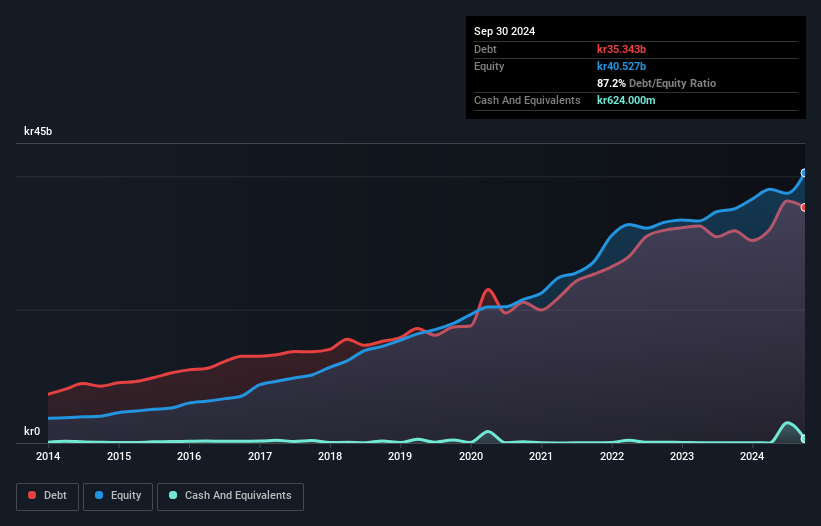Howard Marks put it nicely when he said that, rather than worrying about share price volatility, 'The possibility of permanent loss is the risk I worry about... and every practical investor I know worries about.' So it might be obvious that you need to consider debt, when you think about how risky any given stock is, because too much debt can sink a company. We note that AB Sagax (publ) (STO:SAGA A) does have debt on its balance sheet. But is this debt a concern to shareholders?
When Is Debt A Problem?
Debt is a tool to help businesses grow, but if a business is incapable of paying off its lenders, then it exists at their mercy. In the worst case scenario, a company can go bankrupt if it cannot pay its creditors. However, a more common (but still painful) scenario is that it has to raise new equity capital at a low price, thus permanently diluting shareholders. Of course, plenty of companies use debt to fund growth, without any negative consequences. When we examine debt levels, we first consider both cash and debt levels, together.
View our latest analysis for AB Sagax
What Is AB Sagax's Net Debt?
You can click the graphic below for the historical numbers, but it shows that as of September 2024 AB Sagax had kr35.3b of debt, an increase on kr31.8b, over one year. And it doesn't have much cash, so its net debt is about the same.

How Healthy Is AB Sagax's Balance Sheet?
The latest balance sheet data shows that AB Sagax had liabilities of kr6.70b due within a year, and liabilities of kr35.7b falling due after that. Offsetting these obligations, it had cash of kr624.0m as well as receivables valued at kr68.0m due within 12 months. So it has liabilities totalling kr41.7b more than its cash and near-term receivables, combined.
This deficit isn't so bad because AB Sagax is worth kr93.1b, and thus could probably raise enough capital to shore up its balance sheet, if the need arose. But it's clear that we should definitely closely examine whether it can manage its debt without dilution.
In order to size up a company's debt relative to its earnings, we calculate its net debt divided by its earnings before interest, tax, depreciation, and amortization (EBITDA) and its earnings before interest and tax (EBIT) divided by its interest expense (its interest cover). This way, we consider both the absolute quantum of the debt, as well as the interest rates paid on it.
AB Sagax has a rather high debt to EBITDA ratio of 9.1 which suggests a meaningful debt load. However, its interest coverage of 5.3 is reasonably strong, which is a good sign. If AB Sagax can keep growing EBIT at last year's rate of 19% over the last year, then it will find its debt load easier to manage. There's no doubt that we learn most about debt from the balance sheet. But ultimately the future profitability of the business will decide if AB Sagax can strengthen its balance sheet over time. So if you're focused on the future you can check out this free report showing analyst profit forecasts.
Finally, a company can only pay off debt with cold hard cash, not accounting profits. So the logical step is to look at the proportion of that EBIT that is matched by actual free cash flow. During the last three years, AB Sagax generated free cash flow amounting to a very robust 100% of its EBIT, more than we'd expect. That puts it in a very strong position to pay down debt.
Our View
AB Sagax's net debt to EBITDA was a real negative on this analysis, although the other factors we considered were considerably better. There's no doubt that its ability to to convert EBIT to free cash flow is pretty flash. When we consider all the elements mentioned above, it seems to us that AB Sagax is managing its debt quite well. Having said that, the load is sufficiently heavy that we would recommend any shareholders keep a close eye on it. When analysing debt levels, the balance sheet is the obvious place to start. But ultimately, every company can contain risks that exist outside of the balance sheet. For instance, we've identified 2 warning signs for AB Sagax (1 can't be ignored) you should be aware of.
Of course, if you're the type of investor who prefers buying stocks without the burden of debt, then don't hesitate to discover our exclusive list of net cash growth stocks, today.
New: Manage All Your Stock Portfolios in One Place
We've created the ultimate portfolio companion for stock investors, and it's free.
• Connect an unlimited number of Portfolios and see your total in one currency
• Be alerted to new Warning Signs or Risks via email or mobile
• Track the Fair Value of your stocks
Have feedback on this article? Concerned about the content? Get in touch with us directly. Alternatively, email editorial-team (at) simplywallst.com.
This article by Simply Wall St is general in nature. We provide commentary based on historical data and analyst forecasts only using an unbiased methodology and our articles are not intended to be financial advice. It does not constitute a recommendation to buy or sell any stock, and does not take account of your objectives, or your financial situation. We aim to bring you long-term focused analysis driven by fundamental data. Note that our analysis may not factor in the latest price-sensitive company announcements or qualitative material. Simply Wall St has no position in any stocks mentioned.
About OM:SAGA A
AB Sagax
A property company, owns and manages a property portfolio in Sweden, Finland, France, Benelux, Spain, Germany, and other European countries.
Established dividend payer with limited growth.
Similar Companies
Market Insights
Community Narratives



